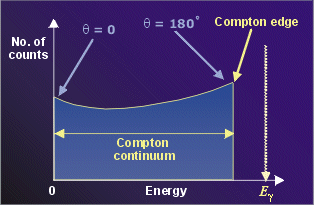

The peak which is near the original x-ray wavelength is considered to be scattering off inner electrons in the carbon atoms which are more tightly bound to the carbon nucleus. That is consistent with the right-hand peak in the illustration above. For scattering from stationary electrons, the formula gives a wavelength of 0.0733 nm for scattering at 90 degrees. Since the spacing of the crystal planes in calcite is known, the angle of diffraction gives an accurate measure of the wavelength.Įxamination of the Compton scattering formula shows that the scattered wavelength depends upon the angle of scattering and also the mass of the scatterer. The spectrometer consists of a rotating framework with a calcite crystal to diffract the x-rays and an ionization chamber for detection of the x-rays.

These were scattered from a block of carbon and observed at different angles with a Bragg spectrometer. 21, 483 22, 409 (1923)) CalculationĬompton's original experiment made use of molybdenum K-alpha x-rays, which have a wavelength of 0.0709 nm. The wavelength change in such scattering depends only upon the angle of scattering for a given target particle.(A. When the incoming photon gives part of its energy to the electron, then the scattered photon has lower energy and according to the Planck relationship has lower frequency and longer wavelength. The scattering of photons from charged particles is called Compton scattering after Arthur Compton who was the first to measure photon-electron scattering in 1922. Here I am stuck since this does not give me the required expression for the shift - just transforming frequencies to the corresponding wavelength does not give me the required result.Compton Scattering Data Compton Scattering Data Which after a little bit of algebra becomes $-$ Therefore from equations $(1)$ and $(2)$, we get $-$ Where $T$ is the energy given to the electron by the photon, which is essentially $h (\nu - \nu_0)$. Now we come to energy conservation: The total energy of the electron is given by $$p c \cos \phi = h \nu_0 + P c - h \nu \cos \theta$$ $$p c \sin \phi = h \nu \sin \theta$$ Where $\nu$ is the frequency of the electron after scattering, $p$ is the momentum of the electron after scattering, and $\phi$ is the electron scattering angle. Then momentum conservation gives, for the $x$- and $y$- axes respectively $-$ Suppose the photon and the electron are both moving initially along the $x$-axis. In proving this, I started in the same way as in the derivation for "stationary electron" - conservation of momentum and energy along each axis. $$\Delta \lambda = 2 \lambda_0 \frac$ is the initial energy of the electron.

The book tells us that this shift is given by In a problem from Bransden and Joachain's Quantum Mechanics, it is asked to calculate the Compton wavelength shift, but the electron is now moving, with a momentum $P$, in the same direction as the approaching photon.


 0 kommentar(er)
0 kommentar(er)
